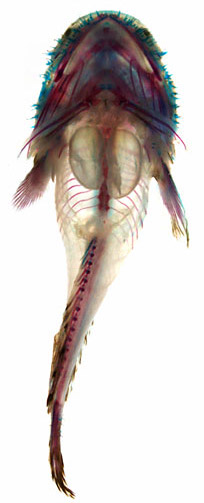Toadfish makes complex sounds, similar to mammals
By Krishna Ramanujan

Nonlinear sounds that may be described as dissonant or jarring are acoustically complex and have been observed in the reproductive, territorial and distress calls of mammals, amphibians and birds, but new Cornell research for the first time finds such nonlinear calls in a fish species.
Cornell researchers first reported in 2009 on the three-spined toadfish (Batrachomoeus trispinosus), a species with a swim bladder that is split in two. Now, a new paper published online May 11 in the journal Proceedings of the Royal Society B: Biological Sciences, analyzed some 1,300 toadfish recordings and found that 35 to 40 percent of the calls had a nonlinear aspect.

"A large proportion of the sounds looked noisy, which means in spectrographic analysis the sound is not neatly contained in frequency ranges," said Aaron Rice, science director of the Bioacoustics Research Program at the Cornell Laboratory of Ornithology and the paper's lead author. Andrew Bass, professor of neurobiology and behavior, and Bruce Land, senior research associate in neurobiology and behavior and in electrical and computer engineering, are co-authors.
Since the early 2000s, a growing body of literature has documented and classified nonlinear vocalizations in mammals and birds. Such calls have been noted in alarm calls of meerkats, crying and screaming of human babies, and calls that serve to identify individuals in penguins. Land used a computer program to compare the structure of nonlinear calls of the fish with those of birds and nonhuman primates.
"Different types of nonlinear calls may have different functions," Rice said. In this way, "examples from the animal kingdom could offer reasonable hypotheses for what these sounds mean in our toadfish."
"This fish has evolved a unique vocal organ that is analogous to our larynx and the syrinx of birds," Rice added. The role of the fish's dual bladders in vocal output was directly shown by clipping the nerve going to one bladder to render it inactive; these fish only made linear sounds like those of fish with one bladder.
"The dual swim bladders offer the behavioral advantage of allowing toadfish to make enriched sounds that travel farther and increase the likelihood of being heard in a potentially noisy aquatic environment," Rice said. Bass pointed out that this discovery adds to a growing body of evidence that the vocal behaviors and underlying mechanisms for sound communication in fish, including control by the brain, have far more in common with other vertebrates, including primates, than previously thought.
Media Contact
Get Cornell news delivered right to your inbox.
Subscribe